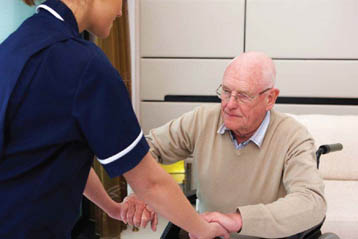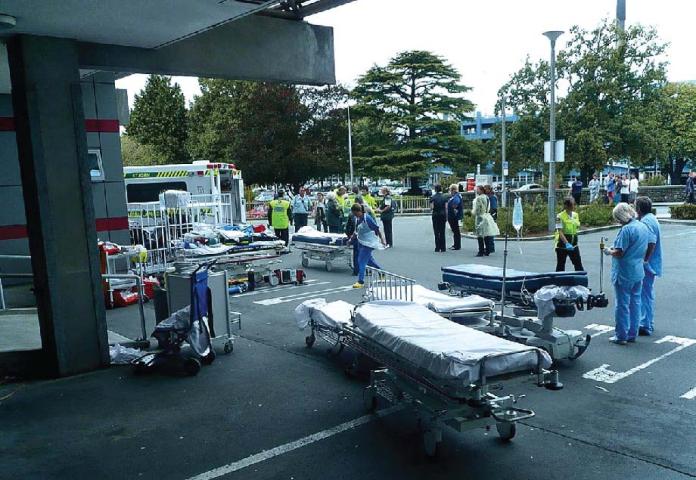New Zealand has capitalised on its small, geographically dispersed population to develop and implement new approaches to healthcare delivery using innovative technology. These innovative approaches are widely seen as models for countries with larger populations facing similar challenges.
When the City of Christchurch was struck by two devastating earthquakes in 2010 and 2011, few people could have imagined the impact they would have had upon the region’s healthcare system. Whilst there were obvious major operational challenges in the immediate aftermath, the catastrophe roused the collaborative spirit of healthcare workers in a remarkable way.
Breaking down silos and implementing a whole of system approach
Canterbury District is New Zealand’s second largest region and is home to a population of 565,000 roughly the same size as Glasgow in the UK and Düsseldorf in Germany. The Canterbury District Health Board is one of twenty across New Zealand. As the recipient of the bulk of public funding for the region, the District Health Board is responsible for the health of the whole community and holds all the health funding plus owns the hospitals.
The hospital at Christchurch is the tertiary hospital for the South Island of New Zealand – a single acute hospital in a geographically isolated location. This has meant we have had to be self sufficient with no options to divert patients elsewhere without a plane ride. Ten years ago, this isolation was causing regular episodes of gridlock with winter bed crises, patient delays in the system and the disengagement of medical staff. These were all drivers for change and so several years prior to the earthquakes, we created a vision to deliver a seamless flow of care rather than responses to a series of individual events.
We wanted a system that provides the right care and support to the right person at the right time and in the right place. This meant a clear commitment to help people stay in the community, freeing up hospital based services to support primary care by providing prompt and effective acute and elective care.
Our strategy was clinically led and focused on addressing and resolving the challenges that a changing population would have on the delivery of healthcare in Canterbury District. A key element was the deployment of health IT –but taking a ‘bottom up’ approach, with an intense focus on deploying IT solutions at the point of care.
We set about the challenge of refocusing the health system around the needs of the patient, confronting the many territorial and proprietary barriers that stand as obstacles to developing a truly integrated care service. The reforms had been progressing well when the earthquakes struck and turned out to be an essential part of delivering a well coordinated crisis response in the aftermath of the most severe earthquake in February 2011. Damaged hospital facilities, the need to move acute services to non acute service locations, challenges in primary care due to damaged buildings, loss of 600 beds in the aged care sector and, of course, the population shift were just some of the problems we faced in those difficult days.
There was also the effect that the earthquakes had on the wider public health. Many people were suddenly living in overcrowded accommodation, with damaged heating systems and poor insulation. Winter was fast approaching too, providing challenges around the management of influenza outbreaks and gastro enteritis. All of these factors made it an absolute imperative to accelerate the pace of change and the reform of our health services.
Reducing hospital admissions
Managing urgent or acute demand is a major source of pressure on healthcare system resources worldwide at the best of times, let alone in a time of crisis. Prior to the earthquake, we had identified that one of our critical challenges was transforming patient flow at Christchurch hospital.
 Therefore, back in 2002, we began work with health IT company Emendo to analyse activity in relation to managing bed occupancy levels, trying to balance acute demand with the need for elective surgery services. As with most hospitals, there were occasions where wards experienced bottlenecks, particularly over the winter period, resulting in delayed stays in the emergency department and cancelled elective procedures.
Therefore, back in 2002, we began work with health IT company Emendo to analyse activity in relation to managing bed occupancy levels, trying to balance acute demand with the need for elective surgery services. As with most hospitals, there were occasions where wards experienced bottlenecks, particularly over the winter period, resulting in delayed stays in the emergency department and cancelled elective procedures.
Emendo developed a system called CapPlan which combined capacity planning services with decisionsupport software to provide timely information that guides operational decision-making. The system accurately forecasts future patient activity on an ongoing basis, and identifies potential congestion or overcapacity in the care process. The system benefits many facets of our hospital operations, by analysing patient trends, mapping workloads,allocating appropriate resources and adjusting operational plans in real time.
This had a major impact, as we could see for the first time, the forecast flow of patients. We could predict three days ahead with better than 99% accuracy how many patients we would have in the hospital and spot the ’bed crunches’ before they occurred. During the first year of implementing CapPlan, CDHB realised cost savings in excess of half a million NZ dollars alone from more effectively planning Christmas/New Year and Easter. ED overcrowding events reduced by over 50%, and there were significant reductions in gridlock events. The indirect benefits were much greater and gave us ‘headroom’ to extend the transformation beyond the hospital walls.
At the same time, we wanted to provide more services in the community to reduce unnecessary hospital visits and admissions and to ensure timely access for people with the more complex health needs. Prior to the earthquake, we had been making good progress, but afterwards, it quite suddenly became essential to take prompt action.
Within weeks of the earthquake, it became clear we needed a strategy to reduce demand for admission to our only acute hospital. The damage done to many of the residential aged care facilities prevented people from moving back for a long period of time, and with Christchurch Hospital stretched to capacity, the earthquake led to the introduction of a community-based initiative for older people. The Community Rehabilitation Enablement and Support Team (CREST)aimed to keep people healthy in their community – enabling people to go home from hospital sooner or avoid going at all. CREST uses HSAGlobal’s Collaborative Care Management Solution (CCMS) as the shared information management platform for the programme. Since it was introduced in April 2011, more than 2,300 people have had their length of hospital stay reduced.
We also enhanced our Acute Demand Management Service (a hospital avoidance process) – perhaps the first in the world to be based out of Primary care. This had a long history going back to the nineties. General practice teams and community nurses deliver a mix of services that support people appropriately in their own homes or community rather than the hospital emergency department. In the past year, 19,644 people were managed in the community via this high quality service and Canterbury now has the lowest rate of acute medical admissions of any large District Health Board in New Zealand for patients of the same age. The use of New Zealand-developed medical devices for the home has also assisted this process including Chiptech’s telecare and telehealth PRU’s (Personal Response Unit) which help people to maintain their health, independence and safety at home.
Overall, in spite of the high level of age related demand, Canterbury has reduced the growth rates of acute medical admissions by 13% over the past 10 years. This significant achievement, has led to an increase in the number of elective surgeries.
Proving the resilience of paperless systems
Another challenge was to deliver a reliable paperless service to give GPs, hospital specialists and administration staff sufficient confidence that the system was robust enough to replace centuries-old paper based processes. Prior to the earthquakes, Canterbury had established regionally held Clinical Data Repositories (CDRs) that recorded all patient interactions in relation to such aspects as laboratory results,picture archiving and communication system (PACS) and,increasingly, medication history. These CDRs were available to varying degrees to primary and community based health services. Contrary to fears, this IT infrastructure held up well during the Earthquakes, whilst some operations which relied on paper-based systems, lost all their data.
New Zealand has a very high level of IT in primary care,with almost all, GPs running paperless management systems. However, after the earthquake it became clear that we needed to share patient records between different health care providers more effectively. We worked with a New Zealand company Orion Health to establish an online information portal to streamline information flows within facilities, organisations and across regions. We call this our electronic Shared Care Record View (eSCRV).
As a result we are now able to provide GP’s, Community Pharmacists, Community Nurses, After Hours GP services and Hospital health professionals with access to a unified patient record at the point of care, integrated with their existing IT systems, resulting in improved quality of care and reduced costs. Right now, we are rolling out this system to bring in the GP records and community nursing. Currently, for example, a GP can, with a single click in patient context, access the whole hospital record and all community pharmacy dispensing. I’m delighted that Orion Health’s clinical integration solutions are now used by more than 300,000 clinicians worldwide to manage and deliver better patient care to around 30 million patients in 30 countries.
Wrapping care around the patient
The accelerated reform programme has also relied on improving patient flow throughout the health system by ensuring that pathways of care are aligned between hospitals and the community and by improving the sharing of patient information systems across community services, general practice teams and hospitals. The collaborations have changed clinical practice and other aspects of the health system in novel ways and for the better. Healthcare professionals have demonstrated remarkable strength and professionalism, frequently putting the needs of patients ahead of their own.
HealthPathways
 HealthPathways may appear to be a simple web-based information system developed for Canterbury clinicians –with a primary focus on general practice. However behind it is an in depth collaborative whole of system approach and close to 700 pathways of care have been developed by primary care and hospital teams. The information on the website has been developed jointly by clinical experts from across the Canterbury health systems who work together to design new models of care that improve the patient journey. While based upon best-practice, NZ or international guidelines, it provides local information about local services. HealthPathways provides assessment, management, referral,and patient information and reference material jointly developed by hospital and general practice clinicians. The information is available to all Canterbury general practices across the region.
HealthPathways may appear to be a simple web-based information system developed for Canterbury clinicians –with a primary focus on general practice. However behind it is an in depth collaborative whole of system approach and close to 700 pathways of care have been developed by primary care and hospital teams. The information on the website has been developed jointly by clinical experts from across the Canterbury health systems who work together to design new models of care that improve the patient journey. While based upon best-practice, NZ or international guidelines, it provides local information about local services. HealthPathways provides assessment, management, referral,and patient information and reference material jointly developed by hospital and general practice clinicians. The information is available to all Canterbury general practices across the region.
HealthPathways is a critical support to the programme to actively manage referrals to hospital and specialist services by the combined clinical community. The locally developed Electronic Referrals Management System (ERMS) interfacesat patient level with the GP clinical record system and supports a referral process based on HealthPathways. It allows the clinical community (GPs and Hospital Specialists) to manage the referrals and hence demand across the sector.
However, it’s not all about providing information for clinicians. Canterbury has also focused its attentions on providing better information for patients and their families and involving them in service improvements.
A newer sister site to HealthPathways named Healthinfo has been developed for patients, empowering people to discover more about their condition and to understand how the health system works. It also provides information about health conditions, tests, medicines, treatments and referral options. The information is completely consistent with the local HealthPathways using a mixture of local content and reliable patient information sites.
The South Island region
A number of the Canterbury generated initiatives have been adopted and are being rolled out across the South Island to run as single instances. These include the Orion Clinical Portal, which is locally named HealthConnectSouth, and now runs as a single instance over three of the District Health Boards and will cover all five by early 2014. Similarly HealthPathways and ERMS are being implemented on a regional basis.
 Where there’s a will, there’s a way
Where there’s a will, there’s a way
So rather than derail our reform plans, the earthquakes accelerated the pace of change. We found that the disaster boosted the use of innovative healthcare models and systems to provide better care to the community.
Clinicians, policy makers, researchers and technicians rose to the challenge, innovating with the active support and participation of health technology companies. The collaborations have improved clinical practice and other aspects of the health system in novel ways.
In the immediate aftermath of the quakes, the fear of change was substantially reduced. I recall a particular meeting with the staff union who said: ‘just tell us what needs to be done and we’ll do it’. This was immensely empowering for all concerned.
Canterbury’s earthquakes brought many challenges, but also provided new opportunities to work with the wider community on aspects that impact on health, such as housing, immunisation and alcohol abuse.
Looking ahead
There is much to learn from the approaches taken by Canterbury DHB and this is especially true in the integration of care through information sharing to drive success.
Nowhere else in the world are clinical systems as much a part of primary care practice as in New Zealand, and this ubiquity is providing a platform for significant breakthroughs.
The Canterbury District Health Board’s achievement in the cost effective provision of healthcare is based on many factors, not least a cultural resilience and self reliance stemming from its geographical isolation. However, it is clear that innovative and prudent investment in technology has played a significant role, driven by a local IT industry that has sought to pioneer new approaches and drive healthcare transformation through collaboration.
Nowhere else in the world are clinical systems as much a part of primary care practice as in New Zealand, and this ubiquity is providing a platform for significant breakthroughs.
For further information about the companies and technology solutions referred to in this case study please contact Belinda Allen at New Zealand Trade and Enterprise, email belinda.allen@nzte.govt.nz
New Zealand Trade and Enterprise is New Zealand’s economic development and trade promotion agency.
Our role is to help New Zealand businesses build strategic alliances and develop commercial relationships internationally. Through a global network of 45 offices, we connect New Zealand businesses with the world, sharing opportunities, knowledge, experience and networks. www.nzte.govt.nz



















